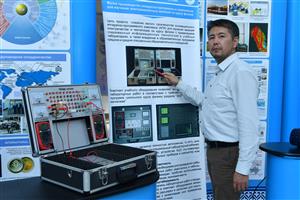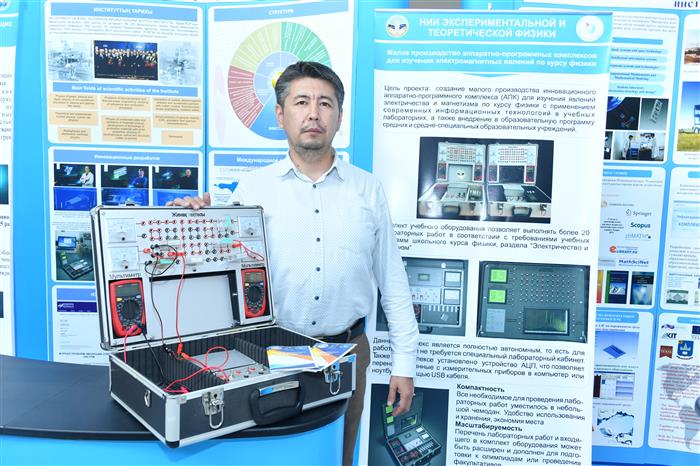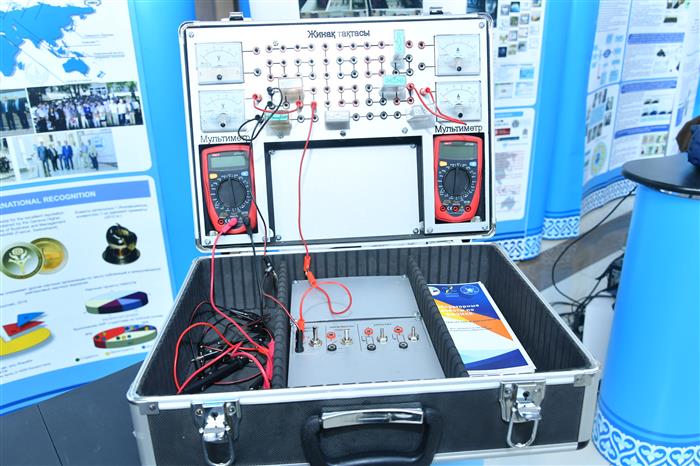- Main page
- News
ALL IN ONE: AUXILIARY FOR TEACHING ELECTRO-MAGNETIC Phenomena
11/11/2021
Not only the educational program but also the quality and structure of the experimental equipment are important for competitiveness. Scientists of KazNU have developed an innovative software and hardware complex for students studying the basics of electromagnetic phenomena in schools.
According to Askar Zhunusbekov, a senior researcher at the Research Institute of Experimental and Theoretical Physics, the main goal of the project was to provide schools with modern, comfortable and safe teaching aids. This is because many educational institutions still use obsolete equipment left over from the Soviet era to conduct experiments in physics.
- The new equipment itself comes from foreign countries, including Russia, China and India. The technology of the last two countries does not meet our standards, and Russian devices are three to four times more expensive than domestic products. That's why we decided to make a cheaper, more convenient product than the imported model. The device we offer meets domestic standards. One of its peculiarities is that we can make changes in accordance with the requirements of the curriculum. It is known from the fifth year that the physical laws do not change, but the teaching methods may change, in which case we will restructure the apparatus, taking into account the state requirements, - he said.
According to the scientist, in the past, when teaching physics, he had his own small suitcase for practical work on each topic. Scientists of the Kazakh National University have combined all these more than twenty works into one device and built a hardware complex.
- For example, with this single device you can measure electrical phenomena such as voltage, current, resistance and its so-called parallel and series, power. The software and hardware complex is small. It does not need to be plugged in because it has a battery inside. There is no stress that endangers human life, so there is no need to worry about the safety of children. Because even if students make mistakes during the experiment, they will not be electrocuted. There are also ways to protect against large and small charges, short circuits, - says Askar Turysovich.
Before the device was put into operation, it was tested in the laboratory of KazNU. And the representatives of the scientific group, who are sure that the device works properly, will distribute pilot versions to schools. Among them is the gymnasium №138 named after M. Bazarbayev. According to Mauletbek Slamiya, a physics teacher at the university, the complex has the potential to integrate with information technology.
- The developed complex is designed to study the basics of the phenomena of electricity and magnetism in the course of school (college) physics. Electrical and magnetism, including the visual demonstration of processes and laws in electromagnetic circuits, modern methods of using hardware and software, as well as the ability to integrate with information technology. For example, the ability to obtain the volt-ampere characteristics of nonlinear elements and automatically graphically represent and analyze them on a personal computer (laptop, tablet) is a good description of the physical processes here. Depending on the capabilities of the functional generator with the elements that make up the hardware-software research complex, it is possible to study the processes, not just linear, in the introductory lesson to this complex electronics and radiophysics. This indicates that the scope of application of the complex is expanding. We can also increase the scope of work of the complex by using additional elements and tools. In my opinion, the laboratory complex is an indispensable tool in the educational process, - he said.
The research complex has a number of indisputable advantages, such as compactness, mobility and autonomy. Equipping secondary schools and colleges with such devices is relatively inexpensive. The physics teacher also said that with the help of this complex it is not difficult to study at home, in the hospital. "In this regard, I appreciate the work of the hardware and software research complex and I am confident that it will be widely used in the future," said Mauletbek Slamiya.
In addition, the hardware complex was widely presented to teachers at many exhibitions in Almaty and Shymkent. Askar Turysovich said that he had a number of suggestions for further improvement of the device.
- Based on this, we updated the design and made changes. Early versions of the device used lead-acid batteries as a power source, while the latest models use lithium. Currently, physics classrooms in Kazakhstani schools need 100,000 such laboratory devices. If we produce at least 1,000 copies a year, it would be enough to justify the project. It can be said that this project has export potential. For example, among the members of the Customs Union, our Kyrgyz brothers and the curriculum in Armenia are similar to ours, - said the expert of the institute.
According to Askar Turysovich, since physics is a fundamental science, its laws will not change in Eurasia or Africa. However, there may be differences in the methodology of teaching physics. For example, in Western countries this subject is not studied in depth. However, the principles of the devices used in the experiment are the same.
- At present, there are digital models of such devices. Everything is displayed on the screen only. In our version, the student creates the chains with his own hands. There were proposals to create a computer version of the device in the project. Earlier, we launched the device in the amount of 158 thousand tenge. The cost does not exceed 100 thousand tenge. The more expensive version has a screen and a small computer. It costs 225 thousand tenge. But it is better to use the simplest version in schools, - he said.
According to the expert, the specialists of the Research Institute of Experimental and Theoretical Physics will do the work themselves, such as the assembly panel required for the hardware complex. And you have to buy additional devices from abroad, such as a digital multimeter. It measures current, voltage and power.
- Initially, this project was a scientific project that emerged as a result of research in the laboratory of the University's science and technology park. For the purpose of commercialization, a state grant for a period of three years was allocated through the Science Fund. With these funds we organized a small production workshop. The intellectual potential of the project is high. Therefore, we are very proud that young scientists are carrying out such work in our laboratory, - said Askar Zhunusbekov.
Camilla Duisen
Innovative complex for the study of electromagnetic phenomena. With this single device, you can measure electrical phenomena such as voltage, current, resistance and its so-called parallel and series power. The software and hardware complex is small. It does not need to be plugged in because it has a battery inside. There is no stress that endangers human life, so there is no need to worry about the safety of children. Because even if students make mistakes during the experiment, they will not be electrocuted.



